How The Penguins Send Us Email
It’s storming again. The Antarctic winds are sweeping the last of the Christmas snow seaward. The Ross Sea is a dark, hammered steel, with no sea ice save for the vivid white of the grounded bergs near shore. But mostly the thick curtain of blowing snow is concealing it all, revealing glimpses only when the wind slows and the snow settles for an instant. I feel restless. We have piles of dark chocolate and other sweets in the hut but what can we do with all this energy when we can’t go outside? ~~~
There are 7 birds equipped with various instruments that have just returned to the colony and I am totally itching to go retrieve them, but the weather is way too unstable right now (60 mph winds and a white out) and we have a long walk to the colony and back. Hiking uphill in this wind totally sucks. You get pushed and shoved and you fall on the hard, slick snow surface and your eyes sting from the blowing snow like hard sand and you can't see a thing, though if the wind catches you by surprise you can almost always follow the rock line back to the hut. We also prefer not to pull the birds off their nests when it’s windy, especially now that the chicks are big enough to run around and out of the nest on their own (most are still a bit wobbly, with stomachs so round and fat and full of food that they mostly tumble around). We'll leave the tags on until the wind eases, hoping that this storm won’t cause the birds to abandon their nests, as they did during a particularly heavy snow storm in January 2005 when all the nests were buried in 1-2 feet of snow and the adults took the opportunity to begin their northward migrations early, along with our precious instruments.
 Chicks! Small but already bottom-heavy...
Chicks! Small but already bottom-heavy... An Adélie, wearing a newly equipped Splash tag and radio transmitter, preening before heading out to seaThe instruments, mostly Splash tags, tell us how deep the birds are diving and where they go while foraging for their chicks at sea. The tags communicate with Argos satellites whenever the penguins are on the water surface. The satellites then email us an automatic message with the birds’ latitude and longitude, so we essentially get emails from the penguins telling us where they are. If we are able to retrieve the tag we can also download the diving data for the entire foraging trip, so we know how deep and how frequently the birds were diving at each location (Adélie penguins can dive as deep as 150 m, though most of the birds here this season are diving to 20-70 m). The penguins' emails arrive each day shortly after 1 PM, and we instantly process them and map them to see how far they are and how soon we can expect to see them back at the colony.
An Adélie, wearing a newly equipped Splash tag and radio transmitter, preening before heading out to seaThe instruments, mostly Splash tags, tell us how deep the birds are diving and where they go while foraging for their chicks at sea. The tags communicate with Argos satellites whenever the penguins are on the water surface. The satellites then email us an automatic message with the birds’ latitude and longitude, so we essentially get emails from the penguins telling us where they are. If we are able to retrieve the tag we can also download the diving data for the entire foraging trip, so we know how deep and how frequently the birds were diving at each location (Adélie penguins can dive as deep as 150 m, though most of the birds here this season are diving to 20-70 m). The penguins' emails arrive each day shortly after 1 PM, and we instantly process them and map them to see how far they are and how soon we can expect to see them back at the colony.
Map showing Ross Island with the three Adélie colonies (Crozier, Royds, and Bird) and the satellite positions we have received to date (December 12-29)
White All Over
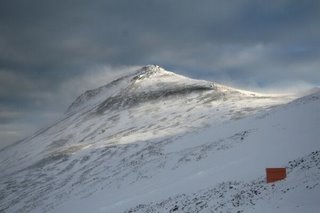 Pat's Peak, which is usually all dark, bare rock, shrouded in new snow. The orange box in the foreground is our survival cache, containing all essentials needed in the event that our hut burns down or blows away.We spent Christmas day measuring penguin chicks and then the snow came – big, fluffy flakes whose highly structured geometry melts away instantly upon impact with clothes or skin, making them difficult to examine closely. The flakes hung and swirled nearly massless in the still air. It snowed like that for the whole next day, making field work nearly impossible. Amélie and Valère went out to retrieve some transmitters, but other than that the heavy snow barred any band searching (when the penguins are covered in snow the silver bands are hard to see) or attaching instruments (we use tape to attach them to the feathers and it loses its sticky properties when wet, leading to the loss of a $3,000 transmitter). Grant went skiing, disappearing into the fog bank above the hut with his skis and skins in the fresh, deep snow. Ian took a ride on the Crozier Cruiser, a contraption not unlike a snowboard but far more splintery than your standard ski slope gear. I tried sledding in a yellow bin large enough to hold a human, but it sank in the snow and didn’t slide an inch. Frozen seal blubber runners would have helped, but I doubt the bin is sleek enough for the job even if outfitted with such polar gear (not to mention the difficulty in obtaining the blubber, which, contrary to popular belief, is not easy to come by in Antarctica, despite the abundance of obliviously sleeping seals).Today is windy, as often happens immediately after a heavy snow, leaving us with a small window of opportunity for skiing or sledding. The snow is blowing in huge billowing clouds and snow devils heading straight north and into the dark sea, where it instantly ceases to be snow and contributes ever so minutely to our rising seas. This is the second storm of the season, giving us a much needed break after nearly a full month without a day off.Christmas eve was rather eventful as far as Cape Crozier goes. My stepmom Deborah and cousin Ben sent us a very large chunk of fresh Parmigiano Reggiano, which arrived in a well-concealed package unbeknownst to everyone else in the hut. I uncovered it on the evening of the 24th, just before dinner, and among many squeals of joy and amazement we quickly proceeded to devour ½ of it. I used some more to make risotto with Lisa’s dried morels and saffron that I brought from home. Wow. I find the sight of fresh Parmigiano in a place where most of the food that we see is either frozen or canned (or both) is incongruous and exciting to such a large degree that I’m sure some people would conclude that I have lost my mind.We received many other great packages from friends and family, most of them involving very good dark chocolate, warm socks, teas, and various other tasty treats. Thank you all!
Pat's Peak, which is usually all dark, bare rock, shrouded in new snow. The orange box in the foreground is our survival cache, containing all essentials needed in the event that our hut burns down or blows away.We spent Christmas day measuring penguin chicks and then the snow came – big, fluffy flakes whose highly structured geometry melts away instantly upon impact with clothes or skin, making them difficult to examine closely. The flakes hung and swirled nearly massless in the still air. It snowed like that for the whole next day, making field work nearly impossible. Amélie and Valère went out to retrieve some transmitters, but other than that the heavy snow barred any band searching (when the penguins are covered in snow the silver bands are hard to see) or attaching instruments (we use tape to attach them to the feathers and it loses its sticky properties when wet, leading to the loss of a $3,000 transmitter). Grant went skiing, disappearing into the fog bank above the hut with his skis and skins in the fresh, deep snow. Ian took a ride on the Crozier Cruiser, a contraption not unlike a snowboard but far more splintery than your standard ski slope gear. I tried sledding in a yellow bin large enough to hold a human, but it sank in the snow and didn’t slide an inch. Frozen seal blubber runners would have helped, but I doubt the bin is sleek enough for the job even if outfitted with such polar gear (not to mention the difficulty in obtaining the blubber, which, contrary to popular belief, is not easy to come by in Antarctica, despite the abundance of obliviously sleeping seals).Today is windy, as often happens immediately after a heavy snow, leaving us with a small window of opportunity for skiing or sledding. The snow is blowing in huge billowing clouds and snow devils heading straight north and into the dark sea, where it instantly ceases to be snow and contributes ever so minutely to our rising seas. This is the second storm of the season, giving us a much needed break after nearly a full month without a day off.Christmas eve was rather eventful as far as Cape Crozier goes. My stepmom Deborah and cousin Ben sent us a very large chunk of fresh Parmigiano Reggiano, which arrived in a well-concealed package unbeknownst to everyone else in the hut. I uncovered it on the evening of the 24th, just before dinner, and among many squeals of joy and amazement we quickly proceeded to devour ½ of it. I used some more to make risotto with Lisa’s dried morels and saffron that I brought from home. Wow. I find the sight of fresh Parmigiano in a place where most of the food that we see is either frozen or canned (or both) is incongruous and exciting to such a large degree that I’m sure some people would conclude that I have lost my mind.We received many other great packages from friends and family, most of them involving very good dark chocolate, warm socks, teas, and various other tasty treats. Thank you all!
Back From the Antarctic Void
We’re back! Our internet has been fixed for a week and we’re busier than ever, so I have had very little time to post. We’re in the peak of our field season right now, and we seem to have barely any time left after sleeping, eating, collecting and entering data. No time to read, barely any time to ski (Grant has gone twice), and very little time for writing, which is one of my favorite things to do here. I am taking lots of photos though – I can’t give that up no matter how busy I am.I was at Cape Royds for about 5 days at the end of November and then flew back to Cape Crozier, where there are currently five of us: Amélie, Valère, Grant, Ian, and myself. Ian is mostly working on the documentary, filming penguins and seals and ice for several hours a day. The rest of us are busy resighting banded birds (we have over 700 and counting), tracking nests, attaching transmitters, and working on our various projects: Amélie is working on her postdoc, Grant and I on our graduate projects, and Valère is busy keeping track of a large portion of the banded nests.Big things that happened so far: Ian arrived in early December, bringing the camp population to 5, which is about as much as this little hut can handle. We all sleep in tents and use the hut only for cooking and running computers, but it’s still pretty tight in here. During storms we generally abandon the tents for fear that they will blow away, but we have yet to have any serious storms since Ian’s arrival. The chicks started hatching about three days earlier than usual, around December 6th, and they are growing fast! It seems that with the iceberg gone the penguins are having a much easier time finding food and feeding their chicks. They are fat and peeping and growing and their stomachs are taut and full of krill and fish.Our species list to date includes (in more or less order of abundance) Adélie penguins, south polar skuas, emperor penguins, Weddell seals, orcas, snow petrels, minke whales, leopard seals, Antarctic petrels, crabeater seals, Wilson’s storm petrels, and a few unidentified whales (probably beaked). There is much more under water, but this is what we can see from our terrestrial vantage point. A short and amazing list of creatures who have adapted to one of the harshest climates on earth.It's 2AM now and I am exhausted, so I'll leave this with a few favorite photos from the past three weeks. More soon.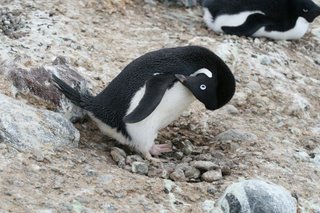 An Adélie penguin giving me the "bill-to-axilla" display (a territorial statement)
An Adélie penguin giving me the "bill-to-axilla" display (a territorial statement)
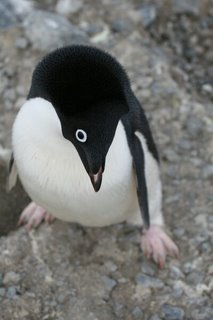 A bad-ass penguin. Adélie penguins can growl quite well - this one was very good at it and nearly attacked me as I tried to squeeze by.
A bad-ass penguin. Adélie penguins can growl quite well - this one was very good at it and nearly attacked me as I tried to squeeze by. The all-black penguin (the only one we know of) has black-and-white mate!
The all-black penguin (the only one we know of) has black-and-white mate!
A south polar skua with its chick.
Wave clouds on the horizon.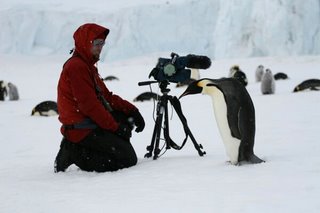 An emperor penguins checking out Grant's filming techniques
An emperor penguins checking out Grant's filming techniques Me. Self-portrait at Cape Royds.
Me. Self-portrait at Cape Royds.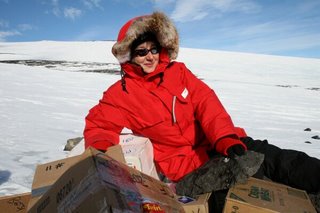 Amelie holding down the boxes on the helicopter pad.
Amelie holding down the boxes on the helicopter pad.
 Valere smiling at the view upon arriving at Cape Crozier (note our orange hut in the background).
Valere smiling at the view upon arriving at Cape Crozier (note our orange hut in the background).













